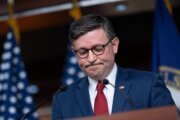The Bipartisan Infrastructure Law and the Inflation Reduction Act put the Energy Department (DOE) in both an enviable and challenging position at the same time. Congress appropriated nearly $100 billion to invest in clean energy, grid reliability upgrades, renewable energy technology manufacturing facilities and much more.
The opportunity to modernize the federal power sector is generational. At the same time, getting the funding out the door to the right organizations to make the right investments will take yeoman’s work.
But this funding and a host of other efforts is part of how DOE is leading the Biden administration’s goal to make the country’s power sector rely on 100% clean energy by 2035.
“We can’t reach those goals without addressing the reliability, the resilience and, of course, the age of our grid. So much of our grid was not just built before I was born, but before my parents and my grandparents were born. And some of these pieces are being held together, instead of being fully upgraded. And it’s everywhere. It’s in our own neighborhood,” said Maria Robinson, director of DOE’s Grid Deployment Office, during WTOP’s Energy Strategy Series 2024.
The office has begun a three-pronged improvement strategy:
- Deploy tools to provide commercial and financial support, including through direct grants.
- Do more planning to prioritize projects. “I know planning is not a terribly sexy topic, but knowing where you can get the most bang for your buck, in terms of some of these investments, is really important,” Robinson said.
- Strengthening and expediting the siting and permitting processes. “That’s one of those areas where we’re trying to balance that need for conservation and making sure that we’re protecting our natural assets through siting and permitting, but at the same time, making sure that we’re doing it in an expeditious way that doesn’t get too bogged down in the bureaucracy of it all,” she said.
DOE office’s sole focus: resilient, adaptable power grid
DOE expects that three-pronged approach to lead to smarter investments in a more resilient and modern grid that relies on new software and hardware.
The department created the Grid Modernization Office in August 2022, and it has grown to more than 150 employees, whose sole focus is on taking advantage of the funding Congress provided through the IRA and BIL.
Robinson said because many of these programs are brand new, her office is trying some novel approaches.
“For example, on the transmission sector, we’re entering into these capacity contracts where the federal government’s actually buying power from certain lines and are agreeing to do so up to a certain point to make sure that some of these lines get built. That’s something that’s never been done before in the history of the federal government,” she said. “It’s working across all the different agencies, with some of the folks over at the Department of Interior or the Department of Treasury — and continuing to foster those relationships. But it is a lot of external engagement.”
Before DOE can start awarding a majority of its funding through grants to state and local, tribal and private sector governments and organizations, it’s conducting a series of studies, including a national transmission planning study and a national transmission needs study.
Samir Succar, senior director for distributed grid strategy at ICF, said this planning is one of the most important pieces to ensuring the power grid cab meet the challenges of today and the future.
Succar said all of the planning that DOE and its stakeholders are doing today will help ensure the nation can balance competing priorities and build a grid that is reliable and affordable.
“Putting planning objectives clearly upfront is a way to articulate the value of a plan and to lay the foundation for the realization of benefits and the attainment of key goals,” he said. “It’s important to recognize that the way we’re thinking about doing planning to meet some of these challenges requires us to do things differently than we’ve done them in the past. Today, it means approaching planning in a fundamentally different way. We’re already starting to see that with some of the work that we do with our clients at ICF. We’re seeing planning groups connecting and integrating plans across transmission and distribution as well as resource planning. We’re seeing planning functions that explicitly incorporate objectives like resilience, flexibility, equity and affordability.”
Succar added these new planning approaches are more sophisticated and take on a multiobjective focus.
Working to relieve energy congestion
Robinson said DOE and its public and private sector partners recognize that investments to either build new or to modernize existing power grids need deliberate planning and a new collaborative approach that ensures long-term flexible solutions.
“We have to figure out where are we want to transport some of these electrons from Point A to Point B in a way that best serves the American people. So that plan can be really complex,” she said. “The needs study helps to point out places where there is some of what we call congestion, which is not unlike traffic congestion that you experience on a bridge. But it means that everything’s moving a little bit more slowly than it should, and it means that things are a little bit more expensive than we think that they could be if they built better infrastructure to accommodate more of the electrons to be able to move.”
DOE published the transmission needs study in October. Robinson said that research already is helping to inform both some of the investments the agency is making and also some of the pieces that it’s working on in the permitting and siting reform efforts.
The transmission needs study assessed existing and current as well as near-term future transmission needs through 2040.
Robinson said the national transmission planning study is an investment grade study to help utilities figure out exactly where investments might need to go or where they would be most beneficial to the system as a whole.
Succar emphasized that recent studies and planning approaches need to recognize the outdated assumption of one-directional power flow from the plant to the customer.
“The system is becoming more dynamic and, to do that, we need to allow for demand flexibility over a variety of operating conditions. That drives the need to plan the system that reflects a broader degree of freedom that we have in terms of flexible management and multidirectional power flow,” he said. “This kind of planning and operation also gives utilities a better sense of how to effectively manage risk and keep the system reliable and safe.”
Permitting reform is coming
The Pacific Northwest National Laboratory and the National Renewable Energy Laboratory with DOE will collaborate with industry stakeholders, communities, and regional and local governments to help identify pathways for necessary large-scale transmission system buildouts that meet regional and national interests.
“We’re really excited about that study that’s coming out somewhere between summer and fall,” Robinson said. “We’re looking forward to it also helping to guide some more of the investments. What we’re trying to do is change the paradigm. But we understand that what we’re trying to achieve here is just one piece, and we want to help the industry as a whole to think more holistically about these problems.”
The third piece of puzzle that DOE is putting in place to ensure the funding gets out the door effectively is a new interagency federal permitting application.
For many federally funded projects, permitting is an arduous process that delays implementation for years, if not decades. Robinson said she expects a final rule in the Federal Register in May.
Additionally, Robinson said DOE also is providing funding for technical assistance to state and local governments to help them with permitting too.
“We’re going to be working with some of those states to help them do some of the analysis that’s necessary in order for them to issue permits and to help provide some of that technical expertise so that those pieces can move faster as well,” she said.
Technology innovations for today, tomorrow
All of this work, Robinson hopes, will make it easier, more efficient and less burdensome on states, local governments, tribal nations and private sector providers to start to implement new and emerging technologies to improve the power grid.
DOE in April released a report highlighting several commercially available advanced grid technologies — such as advanced conductors, dynamic line rating and energy storage — that can increase the existing grid’s capacity to support peak demand growth.
This will allow for innovative new solutions that can tie together some proven technologies, Robinson said.
“Through those efforts, we’ll be able to better predict and identify and then actually address some problems in real time,” she said.
As an example, Robinson pointed to the use of microgrids for areas of the country that historically have had to manage sudden lost power.
“I’m thinking in particular, in some disadvantaged communities like New Orleans. They’re putting in hundreds of microgrids, understanding that they ran into an issue when a very critical transmission line went down during a hurricane,” she said. “So instead, now they’re trying to figure out how to ensure that critical areas, like hospitals and community centers that are providing life saving strategies and benefits, will have power during some of these times — knowing hurricanes are going to come in Louisiana. We know that’s going to happen, so what can we do to get ahead of it and make sure that we’re providing some real economic development and great jobs?”
Succar added that with solar panels getting cheaper and batteries lasting longer, these and other technologies can support the grid in new and varied ways.
“We need as many scalable pathways as possible. We need to meet the urgency of the moment by finding multiple avenues to reach our goals and pursue in parallel as many as practical,” he said. “We need to think broadly about how we leverage what we call the three Ps: pricing, procurement and programs. There was a big focus on contracts and procurement when the industry first started looking at distribution grid services a number of years ago. Those solutions never scaled, in part for some of the reasons around complexity and certainty. But next, there was a focus on markets and price formation and participation rules to enable local resources to participate in regional markets.
“However, today, the most valuable market products remain expensive and complex. What we’re seeing now with some of our clients is a renewed focus on customer programs that have the potential to drive investment at scale. They have the potential to align financial and physical requirements of the system. That’s been under our noses all along. These are the same mechanisms that had been driving energy efficiency investments for decades.”
To discover more ways that governments, nonprofits and businesses are innovating to reimagine approaches to energy use, go to WTOP’s Energy Strategy Series 2024.








